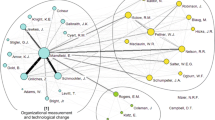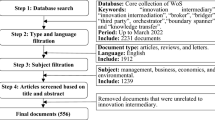Abstract
Innovation in medicine is a complex process that unfolds unevenly in time and space. It is characterised by radical uncertainty and emerges from innovation systems that can hardly be comprehended within geographical, technological or institutional boundaries. These systems are instead highly distributed across countries, competences and organisations. This paper explores the nature, rate and direction of the growth and transformation of medical knowledge in two specific areas of research, interventional cardiology and glaucoma. We analyse two large datasets of bibliometric information extracted from ISI and adopt an empirical network approach to try to uncover the fine structure of the relevant micro-innovation systems and the mechanisms through which these evolve along trajectories of change shaped by the search for solutions to interdependent problems.
Similar content being viewed by others
References
Ahuja, G. (2002), Collaboration networks, structural holes and innovation: A longitudinal study, Administrative Science Quarterly, 45(3): 425–455.
Airaksinen, P. J., Heijl, A. (1983), Visual field and terinal nerve fiber layer in early glaucoma after optic disk hemorrhage, Acta Ophthalmologica, 61(2): 186–194.
Arora, A., Gambardella, A. (1990), Complementarity and external linkages: The strategies of large firms in biotechnology, Journal of Industrial Economics, 38(4): 361–379.
Barabasi, A. L. (2002), Linked: The New Science of Networks, Perseus Publishing, Cambridge MA.
Barkan, O. (1954), Narrow angle glaucoma-pupillary block and the narrow angle mechanism, American Journal of Ophthalmology, 37(3): 332–350.
Bhattacharya, S., Kretschmer, H., Meyer, M. (2003), Characterizing intellectual spaces between science and technology, Scientometrics, 58(2): 369–390.
Batagelj, V. (2002), Efficient Algorithms for Citation Network Analysis, Working Paper, Department of Theoretical Computer Science, University of Ljubljana.
Batagelj, V., Mrvar, A. (2003), Pajek: Analysis and Visualization of Large Networks, Institute of Mathematics, Physics and Mechanics, Department of Theoretical Computer Science, University of Ljubljana, Preprint series 41, pp.871.
Blume, S. (1992), Insight and Industry: On the Dynamics of Technological Change in Medicine, MIT Press Boston.
Blume, S. (1995), Cochlear implantation: Establishing a clinical feasibility 1957–1982, In: N. Rosenberg et al. (Eds), Sources of Medical Technology, National Academy Press, Washington.
Borgatti, S. P. (2005), Centrality and network flow, Social Network, 27(1): 55–71.
Carlsson, B. (Ed.) (1995), Technological Systems and Economic Performance: The Case of Factory Automation, Kluwer Academic Publishers, Dordrecht and London.
Chandler, P. A. (1952), Narrow-angle glaucoma, AMA Archives of Ophthalmology, 47(6): 695–716.
Consoli, D., McMeekin, A., Ramlogan, R., Mina, A., Tampubolon, G., Metcalfe, J. S. (2005), Progress in Medicine: The Structure and Evolution of Know-How for the Treatment of Glaucoma, Paper prepared for the DRUID Conference, June 27–29, Copenhagen.
Cooke, P., Uranga, M. G., Etxebarria, G. (1997), Regional innovation systems: institutional and organisational dimensions, Research Policy, 26(4/5): 475–491.
Coombs, R, Harvey, M., Tether, B. (2003), Analysing distributed processes of provision and innovation, Industrial and Corporate Change, 12(6): 1125–1155.
Delcourt, C., Villattecathelineau, B., et al. (1995), Visual impairment in type-2 diabetic patients — a multicenter study in France, Acta Ophthalmologica Scandinavica, 73(4): 293–298.
Dosi, G. (1982), Technological paradigms and technological trajectories: A suggested interpretation of the determinants and directions of technical change, Research Policy, 11(3): 147–162.
Drance, S. M., Airaksinen, P. L., Price, M., Schulzer, M., Douglas, G. R., Tansley, B.W. (1986), The correlation of functional and structural measurements in glaucoma patients and normal subjects, American Journal of Ophthalmology, 102(5): 612–616.
Edquist, C. (Ed.) (1997), Systems of Innovation: Technologies Institutions and Organization, Pinter, London.
Fischman D. L., Leon, M. B., Baim, D. S., Schatz, R. A., Savage, M. P., Penn, I., et al. (1994), A randomised comparison of coronary stent placement and balloon angioplasty in the treatment of coronary artery disease, New England Journal of Medicine, 331: 496–501.
Freeman, C. (1991), Networks of innovators: A synthesis of research issues, Research Policy, 20(5): 499–514.
Freeman, C. (1995), The national systems of innovation in historical perspective, Cambridge Journal of Economics, 19(1): 5–24.
Fuchs, V. R., Sox, Jr. H. C. (2001), Physicians’ views of the relative importance of thirty medical innovations, Health Affairs, 20(5): 30–42.
Gelijns, A., Rosenberg, N. (1999), Diagnostic devices: An analysis of comparative advantages, In: Mowery, D., Nelson, R. (Eds), Sources of Industrial Leadership, Cambridge University Press, Cambridge.
Gelijns, A. C., Rosenberg, N. (Eds) (2005), Sources of Medical Technology: Universities and Industry, Institute of Medicine, National Academy Press, Washington.
Katz, J. S., Hicks, D. (1997), Bibliometric Indicators for National Systems of Innovation, IDEA Paper Series 12, available at: www.sussex.ac.uk/Users/sylvank/best/nsi/index.html
Hummon, N. P., Doreian, P. (1989), Connectivity in a citation network: The development of DNA theory, Social Networks, 11(1): 39–63.
Jonas, J. B., Gsek, G. C., Naumann, G. O. H. (1998), Optic disk morphometry in chronic primary open angle glaucoma, Graefes Archive for Clinical and Experimental Ophthalmology, 226(6): 522–530.
Krupin, T., Mitchell, K. B., Johnson, M. F., Becker, B. (1978), Long term effects of iridectomy for primary acute angle closure glaucoma, American Journal of Ophthalmology, 86(4): 506–509.
Leydesdorff, L., Meyer, M. (Eds) (2003), The Triple Helix of university-industry-government relations, Scientometrics, 58(2): October 2003.
Lundvall, B. A. (Ed.) (1992), National Systems of Innovation: Towards a Theory of Innovation and Interactive Learning, London, Pinter.
Malerba, F. (Ed.) (2004), Sectoral Systems of Innovation, Cambridge University Press, Cambridge.
Metcalfe, S. J., James, A., Mina, A. (2005), Emergent innovation systems and the delivery of clinical services: The case of intra-ocular lenses, forthcoming in Research Policy.
Mina, A., Tampubolon, G., Ramlogan, R., Venetucci, L., McMeekin, A., Metcalfe, J. S. (2004), Problem Sequences and Innovation Systems: Emergence, Growth and Transformation of a Medical Sector, CRIC Working Paper No. 14, University of Manchester.
Murray, F. (2002), Innovation as co-evolution of scientific and technological networks: Exploring tissue engineering, Research Policy, 31(8/9): 1389–1403.
Nelson, R. R. (1993), National Innovation Systems: A Comparative Analysis, Oxford University Press, Oxford.
Newman, M. E. J. (2000), Who is the Best Connected Scientist? A Study of Scientific Co-authorship Networks, SFI Working Papers No. 00-12-064, Santa Fe, New Mexico.
Owen-Smith, J., Powell, W. W. (2003), The expanding role of university patenting in the life sciences, Research Policy, 32(9): 1695–1711.
Powell, W. W., Koput, K. W., Smith-Doerr, L. (1996), Interorganizational collaboration and the locus of innovation: Networks of learning in biotechnology, Administrative Science Quarterly, 41(1): 116–145.
Powell, W. W., Grodal, S. (2005), Networks of innovators, In: Fagerberg, J., Mowery, D. C., Nelson, R. R. (Eds), The Oxford Handbook of Innovation, Oxford University Press, Oxford and New York.
Posner, A., Schlossman, A. (1948), Syndrome of unilateral recurrent attacks of glaucoma with cyclitic symptoms, Archives of Ophthalmology, 39: 517.
Quigley, H. A., Addicks, E. M., Green, W. R., Maumenee, A. E. (1981), Optic nerve damage in human glaucoma, Archives of Ophthalmology, 99(4): 635–649.
Quigley, H. A. (1982), Childhood glaucoma — Results with trabeculotomy and study of reversible cupping, Ophthalmology, 89(3): 219–226.
Ramlogan, R., Tampubolon, G. (2004), Paper presented at the Uneven Growth of Knowledge, Workshop, European University Institute, Florence 12–13th March.
Tether, B. S., Metcalfe, J. S. (2003), Horndal at Heathrow? Capacity expansion through co-operation and system evolution, Industrial and Corporate Change, 12(3): 437–476.
Utterback, J. M. (1994), Mastering the Dynamics of Innovation, Harvard Business School Press, Boston.
Wagner, C. S., Leydesdorff, L. (2004), Network Structure, Self-Organizationa and the Growth of International Collaboration in Science, Amsterdam School of Communications Research, University of Amsterdam, available at: http://users.fmg.uva.nl/lleydesdorff/cwagner/collabnets.pdf
Walsh, J. P., Bayma, T. (1996), The virtual college, Information Society, 12(4): 343–363.
Author information
Authors and Affiliations
Corresponding author
Rights and permissions
About this article
Cite this article
Ramlogan, R., Mina, A., Tampubolon, G. et al. Networks of knowledge: The distributed nature of medical innovation. Scientometrics 70, 459–489 (2007). https://doi.org/10.1007/s11192-007-0212-7
Received:
Issue Date:
DOI: https://doi.org/10.1007/s11192-007-0212-7




